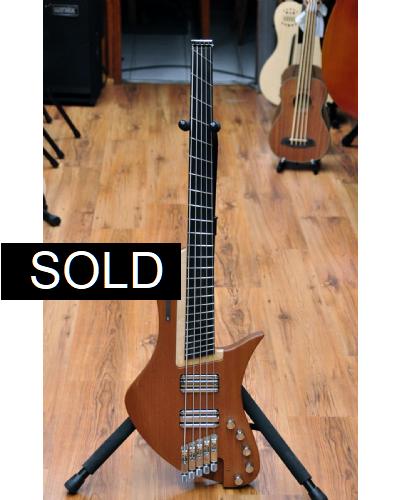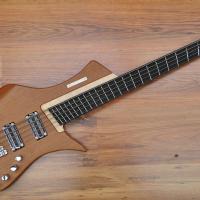- Mahogany body
- Maple neck
- D neck profile (comfort)
- Ebony fingerboard
- Phosphorescent side dots
- 5 strings: B, E, A, D, G
- Multidiapason: 838 - 889 mm (33 "- 35")
- String spacing: 17 mm
- 24 medium frets
- Fret 0.
- 2 Lace Alumitone splittable humbucker pickups
- Active electronics
- Bass, treble, midrange control
- Volume control (push-pull), tone
- Satin finish
- Hardware: chrome
- Strap Fasteners: Dunlop Flush Mount
- Weight: 4.0 kg
- Supplied in soft cover
Those of you who have played a Claas instrument know what I’m talking about – you’ve experienced the superior, incredibly smooth feeling frets we have on all of our guitars and basses.
As musicians, many of us have also experienced the opposite. It is taken as standard that frets encounter all sorts of problems, and that taking a guitar to a luthier for fretwork can be a semi-regular part of owning the instrument. This comes from the inconsistent and often outdated way that fretwork is approached by the majority of brands and builders. And that’s why so many of us have experienced fret sprout, dead spots, sharp edges and worse.
I decided that this shouldn’t be accepted as standard anymore. We shouldn’t accept second-rate fretwork on our high-quality instruments. And so we ensure that our frets feel smoother and more comfortable for longer, applying our knowledge and experience to have far better frets than most players are used to. This shouldn’t be underestimated for the musician; it means smoother playability, fewer maintenance issues, and a much more enjoyable playing experience.
So, how do we achieve this?
Simply put, we have moved away from the standard practices used by many builders, and have instead developed our own unique process for fretting guitars and basses. With a massively improved process comes far better results, and so we have our super-round, ultra-smooth frets. It’s the recipe for perfect fretwork, every single time.
How different can this process be? How exactly does it ensure better frets?
Let’s compare the Claas process to the standard process so we can really see the difference. After this rundown, it will be clear how much more time and effort we put into our method, and how superior fretwork is the result.
Fret slots
We start off with CNC. Surprised, huh? Of course, words such as ‘handcrafted’ apply to the most coveted instruments in the world. Handwork plays a huge role in our guitars too (including for fretwork, in just a moment!) but the best possible guitar is not 100% made by hand. The human eye can be accurate up to about ½ millimetre, whereas a machine can be accurate up to 1/100th of a millimetre. There are certain tasks where human hands and the touch of an experienced guitar builder are best (at least until hyper-intelligent robots rise up and crush humanity). But for other tasks, the precision work of a machine is essential for achieving the best possible result.
And so perfect fretwork starts with cutting the fret slots using our CNC machine. We pre-cut the slots with a saw-blade, then use a router. This means we have to change the router bit less often, and so is more efficient. By doing this with consistent machine precision, it lays the foundation for flawless frets.
If this step is anything less than flawless, it will be near impossible to have high-quality fretwork at the end – no matter how good the rest of the work is. This is especially important for us, as we build a lot of custom instruments with fanned frets or fretboards that are half-fretless. Cutting ultra-precise fret slots is essential.
On most guitars, the fret slots are cut all the way through the fretboard: if you look at the side of the fretboard, you can see the slot going all the way through. This is quick and easy, but not the best method. It puts the end of the fret right at the edge of the fretboard. This is why so many guitars suffer fret sprout, where the fret sticks out from the edge of the wood and can poke or even cut your hand. Wood expands and contracts over time, and if the frets are placed right to the edge, this fret sprout can happen quite easily as the wood changes.
This standard method can also feel a little rough and less comfortable even without fret sprout, as the fret ends can bump and catch your fretting hand as you move up and down the neck.
We resolve these issues by cutting our fret slots further away from the edge of the fretboard. Having the router start and stop cutting slightly in from the edge means the fret end will not sit at the very edge of the fretboard. Already, before even touching a fret, we have ensured smoother playability and reduced the risk of fret sprout. It’s a small, simple change that makes a huge difference.
This is too time-consuming for the bigger companies. In their method, they push a fretboard into a machine with one sawblade for each slot, and cut all of them all the way through the fretboard. This takes less than 10 seconds. They would also use a machine with a single sawblade, again cutting all the way through the slots, which would take around 10 minutes. Our method takes around 1 hour per fretboard. It’s worth it for the clear advantages it gives the musician – true quality takes time.
So already from the first step, the Claas Guitars method creates a foundation for superior fretwork.
Cutting the fretwire
We do this by hand, as is quite standard. We then spend 20-30 seconds per fret cutting off the end of the fret tang (the part of the fret that fits into the fret slot). We do this with a special tool, again by hand, and we double check every single cut to make sure they are all done cleanly.
But again, we quickly bring in our own methods, improving on the normal industry process. At this point in the building of almost every other guitar, the frets are pressed into the fretboard with the fret ends hanging over the edge of the wood, and these are then cut and sanded.
Not at Claas Guitars! We don’t press the frets yet. Instead, we take a file and some sandpaper, and we pre-round every single fret end, then polish every single one, all by hand.
This takes a lot more time than the standard process, but it’s an investment in the quality of the instrument. The result is a playing experience that’s as smooth and enjoyable as possible. No poking fret ends, no friction against your fretting hand – just a feeling of gliding over the fretboard. It makes for a better-looking fretboard as well, which is not a bad thing! But the real difference is in the playability, something that you can feel right away under your fingers.
Pressing the frets
Yes, even with such a relatively simple step, there is a Claas Guitars difference! All of the hard work perfecting the slots and fret ends will be wasted if we don’t take our time and press the frets with absolute accuracy and perfection.
Checking, checking, and checking again, we ensure that every single fret is perfectly centred to get the best look and feel possible. Like with the previous steps in the process, this means that we spend a lot more time pressing our frets when compared to other guitars. Again, this is an investment in the playability of the instrument, one that will truly pay off for the musician when it comes to creating and performing the music they love.
Spot the difference
Overall, this means we put a huge amount of time and effort into the fretwork of every single guitar and bass we build. From cutting the fret slots and the fretwire to rounding the ends and pressing the frets, to levelling and re-crowning and polishing, we spend around 4-5 hours on each individual guitar’s fretwork. This is an incredibly long time – far more than is spent on almost any other guitar on the market.
But it is so worth it. The smooth feel and playability is unparalleled, and we hear from musicians again and again that our guitars feel amazing in their hands. A better feeling guitar can inspire you to play better, to be more creative in writing music and to be a more confident performer. Perhaps most importantly, it can bring more joy to your playing and practising, and keep you loving your guitar for years and decades to come.
That’s the difference we want to create. In investing time and effort into developing our unique approach to fretwork, and in putting more hours and more precision work into each instrument, we ensure a playing experience unlike any other. That’s the magic of perfect fretwork.





